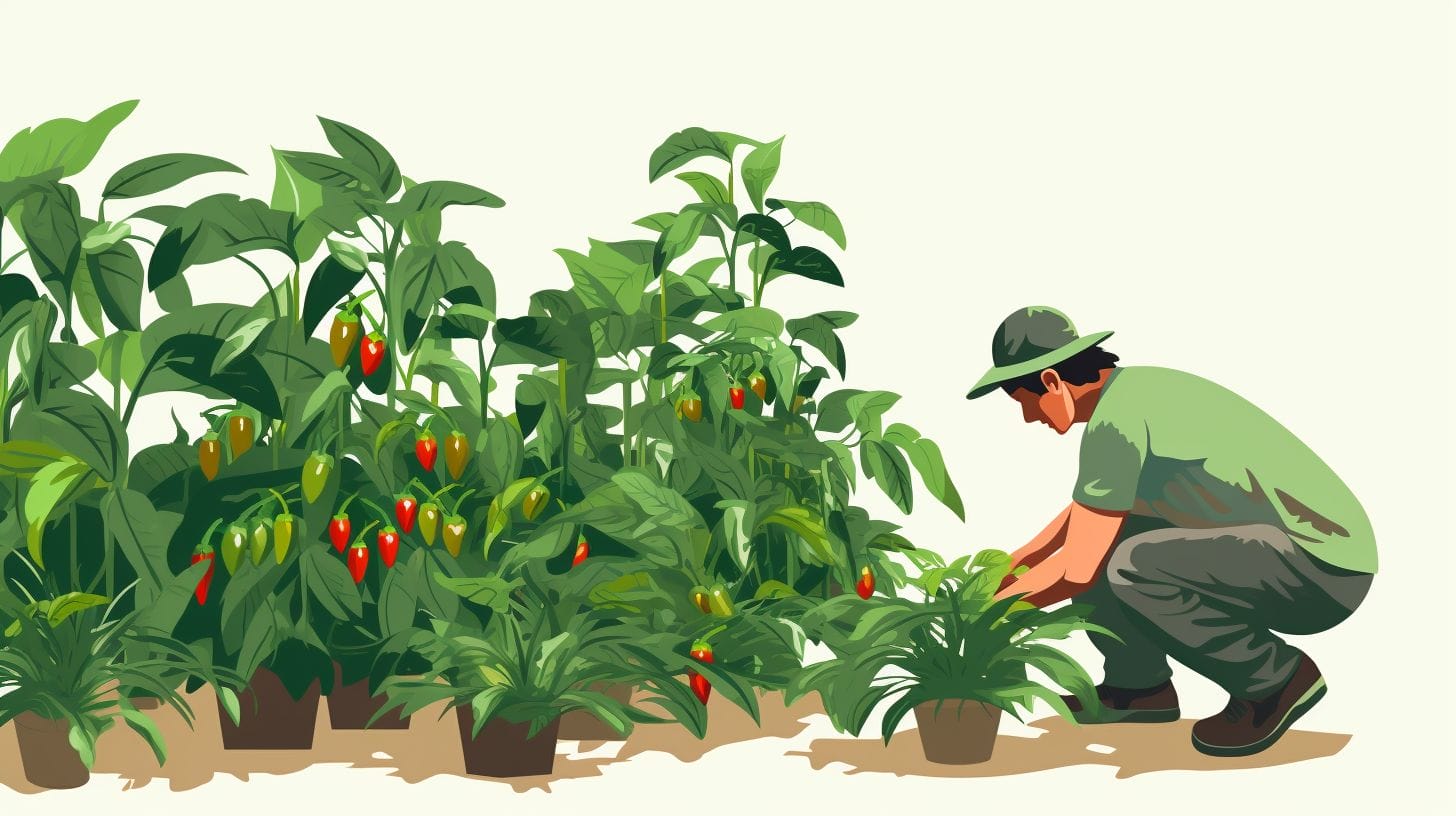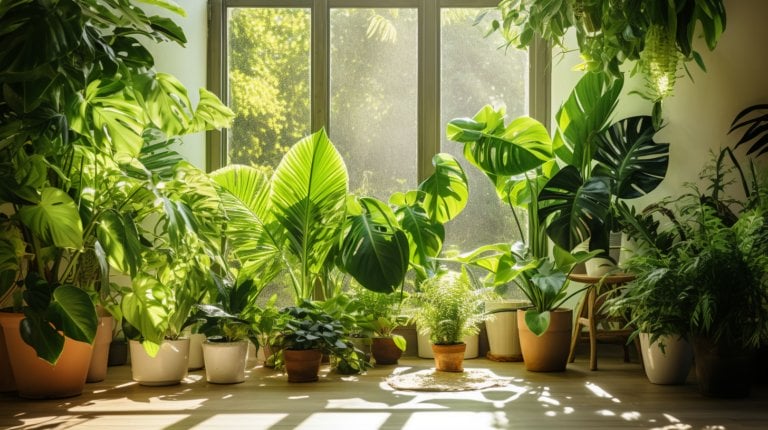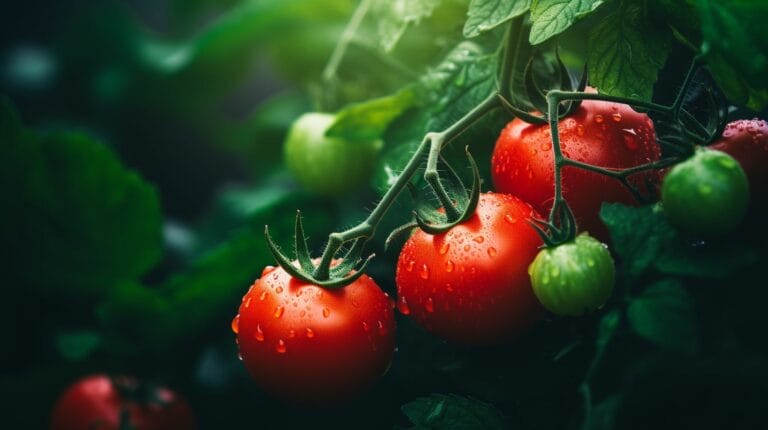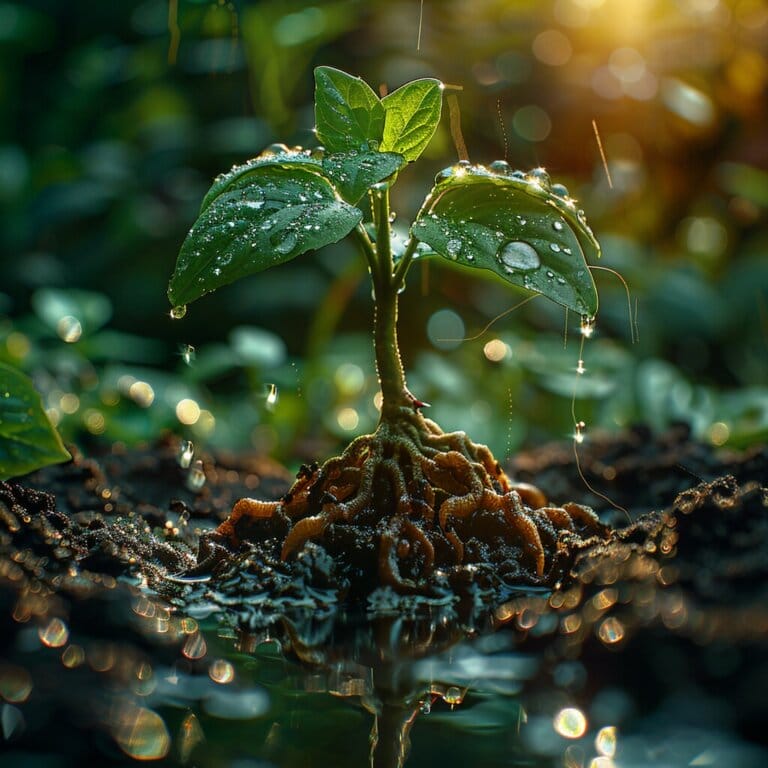How to Care for Jalapeño Plants: Quick Guide to Grow Jalapeño Peppers
Learning how to look after jalapeño plants can provide immense joy to your gardening experience. Sadly, many individuals fail to cultivate their favorite hot peppers, under the mistaken belief that caring for a pepper plant is excessively demanding.
But fear not! With a sprinkle of horticultural wisdom and some tried-and-true tips from my years tending to gardens, you’ll find that raising these fiery friends is more joy than a job.
Jalapeños aren’t just little packets of heat; they’re garden powerhouses that light up your taste buds and bring life to your backyard ecosystem. Boasting a spiciness level between 2,000 to 8,000 Scoville Heat Units, these spirited peppers do more than add a kick to dishes—they carry the heart of Mexican cuisine right into your home garden.
So roll up those sleeves and get ready to foster some greenery with gusto. We’ll uncover easy-to-follow plant care techniques so your jalapeño harvest will be as hearty as hot.
Trust me; once you’ve got the hang of it, you’ll wonder why you didn’t start sooner!
Key Takeaways
- Jalapeño plants need at least 6 hours of sunlight daily and thrive in well-draining, compost-rich soil with a pH level between 6.0 and 7.0.
- Water deeply but infrequently, aiming for around 1 – 2 inches of water per week, and ensure consistent soil moisture without waterlogging to avoid root rot.
- Pruning suckers around the base of the plant can help direct energy toward fruit production while understanding pollination processes and managing pests and diseases is critical for a bountiful jalapeño harvest.
- Maintaining optimal humidity levels is crucial for healthy jalapeño growth, as they require moderate humidity to thrive without facing fungal diseases or mold issues.
Jalapeño Pepper Fundamentals
Jalapeño peppers are popular chili peppers known for their moderate heat and versatile use in various cuisines. They belong to the Capsicum annuum species and are part of the nightshade family, including tomatoes, potatoes, and eggplants.
Quick Jalapeño Facts
I love growing my own food, and jalapeño peppers are one of my favorites. They’re spicy, tasty and add a zing to any meal. Here’s what you need to know about them:
- Jalapeño peppers spice things up with 2,000 – 8,000 Scoville Heat Units.
- You can grow them yearly in places where it’s really cold or hot all year round.
- If the ground is warm enough, at least 65°F, you can plant jalapeño seeds right outside.
- Starting seeds inside your home is smart if you still have cold days ahead; do this about 8 – 10 weeks before the last frost is expected.
- These peppers love sunbathing for at least 6 hours daily in full sunlight.
- To keep jalapeños happy, feed them lots of compost because they’re always hungry for nutrients.
- A grown-up jalapeño plant can get as tall as your kitchen counter and give you dozens of peppers over several weeks.
- When the season ends, don’t throw out your jalapeños! You can dry, freeze, or make some salsa or sauces to keep enjoying their kick.
The Appeal of Growing Jalapeño Peppers
Growing these peppers is a joy for many reasons. They bring a spicy kick to dishes like chili, salsa, and poppers. But the thrill isn’t just in the taste. Planting these peppers can be quite easy once you know how. They don’t need much space and love the sun. You can grow them in pots or gardens. Jalapeños also give your garden a bright green color as they grow into plump little heat gems. People enjoy watching the small white flowers bloom and turn into peppers right before their eyes. And there’s a proud moment when picking that first ripe jalapeño from your own plant! These plants even help with healthy eating because you’ll have fresh, organic peppers anytime.
Planting Jalapeño Peppers

To start growing jalapeño, choosing the right time and location for planting is essential. Select a sunny spot with well-draining soil enriched with organic matter. Whether planting seeds or transplanting seedlings, ensure the soil is moist but not waterlogged to promote healthy growth.
Choosing the Right Time and Garden Location
I always pick the perfect spot and time for my jalapeños. They need a warm start, so I wait until the soil reaches 65 degrees Fahrenheit. This means after all signs of frost are gone, spring is in full swing. I find a sunny place where the sun plays on the leaves for about six hours or more each day. The spot needs good dirt, too, rich with organic matter and able to drain water well. It’s smart to begin seeds indoors around 8 to 10 weeks before that last chilly night is expected.
Then, once outside nights stay above 60 degrees Fahrenheit, that’s my cue—it’s time to move those young plants from their cozy indoor spots into the garden. Getting this timing right helps me avoid any cold damage that could really stress my pepper friends out!
Soil Requirements and Preparation
Growing jalapeño starts with good soil. It’s my job to ensure my soil is ready for these spicy friends.
- Pick a spot in your garden that gets lots of sunshine.
- Jalapeño loves soil with lots of organic stuff, like compost.
- Ensure the soil drains well so the roots don’t sit in water.
- Test the soil to see if it’s around 65 degrees Fahrenheit, which is warm enough for planting seeds.
- The soil should be slightly acidic to neutral. This means the pH level should be between 6.0 and 7.0.
- Mix in some compost or a balanced fertilizer to improve your soil before planting.
- Break up big dirt clumps so tiny roots can move through easily.
- Water the spot you will plant in so the soil is moist but not too wet.
- Let the ground have some time to settle after you’ve added all your nutrients and watered it.
Planting Jalapeño Seeds vs. Transplanting Seedlings
When planting jalapeños, you can either start from seeds directly in the garden or begin indoors and then transplant seedlings outside. Here’s a detailed comparison to help guide your decision:
Planting Jalapeño Seeds
- Prepare the soil by ensuring it’s well-draining and rich in organic matter.
- Sow the seeds about 1/4 inch deep and keep them consistently moist for germination, which usually takes 2-3 weeks.
- Thin out the weaker seedlings once they have their first true leaves, leaving the strongest ones spaced about 14-16 inches apart.
Transplanting Jalapeño Seedlings
- Start seeds indoors 6 – 8 weeks before your last expected frost date.
- Use biodegradable pots or peat pellets to minimize root disturbance when transplanting outdoors.
- Harden off seedlings by gradually exposing them to outdoor conditions over 7 – 10 days before planting them in their final spots.
How To Care For Jalapeño Plants

Once the jalapeño seeds are sown or the seedlings are transplanted, it’s crucial to provide optimal sunlight and temperature conditions, proper watering, humidity management, and regular fertilizing to ensure healthy plant growth.
Additionally, pruning for plant health and yield, understanding pollination processes, and effectively managing pests and diseases are essential nurturing practices for growing robust jalapeños.
Optimal Sunlight and Temperature Conditions
Jalapeño thrive in full sun, so they need at least 6 hours of sunlight every day to grow well. The ideal temperature range for growing jalapeños is between 65-85 F (20-29 C) during the day and 60-70 F (16-21 C) at night.
These optimal conditions will help your jalapeño flourish and produce an abundant harvest.
Watering Guidelines for Jalapeño Plants
To keep your jalapeño healthy and thriving, here are some watering guidelines you should follow:
- Water deeply but infrequently, aiming for around 1 – 2 inches of water per week.
- Ensure the soil is consistently moist but not waterlogged to avoid root rot.
- Water at the base of the plant prevents wetting the leaves, which can lead to diseases.
- Use drip irrigation or a soaker hose to deliver water directly to the roots and minimize evaporation.
- Increase watering frequency during hot and dry periods to maintain soil moisture levels.
The Role of Humidity
Humidity is crucial for jalapeño. They need moderate humidity to grow well. If the humidity gets too low, it can cause stress for the plants and affect their growth. However, excessive humidity can lead to problems like fungal diseases and mold, harming the jalapeño.
Therefore, maintaining the right levels of humidity is essential for ensuring healthy growth and avoiding potential challenges such as disease development.
Overall, paying attention to humidity levels and providing adequate moisture in the air will contribute significantly to successfully cultivating jalapeño peppers.
Fertilizing for Healthy Growth
Jalapeño benefits from additional side dressing of compost or a balanced fertilizer. They are heavy feeders and require proper fertilization for healthy growth. Fertilizing helps in the optimal production of jalapeños, ensuring they have the nutrients needed for robust growth and abundant pepper yield.
Jalapeño Maintenance Practices
It’s important to focus on maintenance practices such as pruning for plant health and yield, understanding pollination, and effectively managing pests and diseases to ensure your jalapeño thrive and bear fruit.
These practices are essential for maximizing the productivity of your jalapeño and ensuring a bountiful harvest of delicious peppers.
Expert Tips for Healthy Jalapeño Plants
Pruning for Plant Health and Yield
Pruning jalapeño plants can boost their health and the number of peppers they produce. Although jalapeños generally don’t need much pruning, it’s beneficial to remove any suckers growing around the base of the plant.
Doing this allows the plant to direct its energy toward the main stems that will bear more fruits. This simple practice helps create sturdier plants and encourages higher fruit production, leading to a bountiful harvest of spicy peppers for your culinary adventures.
Remembering these key points from our growing guide can help ensure a healthier jalapeño and a more abundant yield come harvest time.
Understanding Pollination
Jalapeño plants do their pollination mainly through the wind and animals like bees. However, they can also cross-pollinate with other types of peppers if those peppers are nearby.
When the plant doesn’t get pollinated properly, it will affect the yield of jalapeños you can harvest. So remember to ensure there are enough pollinators around your plants and try not to stress them out because this may hinder their ability to produce lots of peppers.
The process is essential for ensuring a bountiful harvest of these spicy delights, so planting flowers or herbs near your pepper plants could attract more helpful insects while increasing biodiversity in your garden.
Pest and Disease Management
Jalapeño plants are prone to diseases like Fusarium wilt and anthracnose and pests such as aphids, mites, cucumber beetle larvae, and pepper hornworms. To protect the jalapeño from these issues, it’s important to regularly inspect the plants for any signs of disease or infestation.
Implementing preventive measures like promoting good air circulation around the plants by properly spacing them can help prevent diseases. Additionally, organic pest control methods such as introducing beneficial insects like ladybugs or using insecticidal soap can effectively manage pests without harming the environment.
Moreover, maintaining a clean garden by removing plant debris and weeds can help reduce the risk of disease transmission. When dealing with pest or disease problems on jalapeño, it’s crucial to address them promptly to minimize damage and ensure healthy plant growth.
Can I Use the Same Care Techniques for Growing Jalapeño Plants and Mock Orange Shrubs?
When it comes to growing mock orange shrubs, the care techniques differ from those used for jalapeño plants. Mock orange shrubs require full sun and well-drained soil. Regular pruning is recommended to maintain their shape. On the other hand, jalapeño plants thrive in warm climates and need consistent watering. So, it’s essential to adapt your care techniques accordingly for each plant.
Harvesting and Enjoying Your Jalapeños
Once your jalapeños have reached their full size and have turned a deep green or red color, they are ready to be harvested. Use sharp scissors or pruning shears to cut the peppers from the plant, leaving a small piece of stem attached.
Store your freshly picked in a paper bag at room temperature for a few days to allow them to fully ripen before enjoying them in salsas, pickling, or adding some spicy flavor to your favorite dishes.
Signs Your Jalapeños Are Ready to Harvest
- Jalapeños are typically ready to harvest when they reach full size, usually around 4 inches long. They should be firm and dark green.
- Another sign that it is ready for picking is when they have developed a smooth, glossy appearance, indicating maturity.
- If left on the plant for an extended period, it will start to change color, transitioning from green to red, orange, or yellow. This shift in color signals that the peppers are fully ripe and can be harvested.
- When harvesting, gently grasp the pepper and give it a slight tug. It is ready to be picked if the pepper easily detaches from the plant without resistance.
- Be sure to avoid waiting too long to harvest it, as overripe peppers may develop a pithy texture and bitter flavor, affecting their overall quality.
- To encourage continuous production of it throughout the growing season, regularly harvest ripe peppers as this will stimulate new flower and pepper development.
- Remember that jalapeños should be harvested before temperatures drop below 35 degrees Fahrenheit, as exposure to frost can damage or even kill the plants.
Storage Tips for Keeping Jalapeños Fresh
After picking fresh jalapeños, properly storing them is essential to maintain their freshness. Firstly, I recommend placing the jalapeños in a perforated plastic bag and storing them in the vegetable crisper drawer of your refrigerator.
This will help maintain the right level of humidity while allowing for proper air circulation. Additionally, consider wrapping the jalapeños in a paper towel before putting them in the bag to absorb any excess moisture that may lead to spoilage.
Another effective method is pickling or canning the jalapeños. You can preserve their flavor and crispness by submerging them in vinegar or packing them with salt and other spices before sealing them in jars.
Dehydrating or freezing are excellent approaches if you prefer preserving their spicy kick. Dehydrating requires slicing the jalapeños into thin pieces and laying them out until they dry completely. At the same time, freezing entails removing seeds and membranes before sealing them tightly in a freezer-safe container or bag.
After mastering the art of growing jalapeño peppers, why not expand your gardening skills? Dive into our guide on how to care for pecan trees to continue your horticultural journey!
Conclusion
In conclusion, caring for jalapeño plants is a practical and rewarding endeavor. Following the strategies in this guide, you can efficiently nurture thriving jalapeño pepper plants and enjoy an abundant harvest.
Have you considered starting your jalapeño gardening journey? The impact of implementing these tips can lead to a bountiful yield of flavorful peppers while contributing to sustainable gardening practices.
Explore additional resources on organic gardening and sustainable cultivation methods for further learning. So, embark on your jalapeño growing adventure with confidence and enthusiasm!
FAQs
How do I start growing jalapeño peppers?
To grow jalapeño peppers, begin by planting pepper seeds in potting soil with good drainage. Keep the soil moist and put it in a spot where it gets full sun.
What are some tips for caring for my jalapeno plant?
Ensure you water your jalapeno at the soil level to keep them from getting stressed. Use straw mulch to hold moisture and pull weeds so your plants aren’t crowded.
When is the right time to pick my jalapeños?
Harvest your jalapeño when they’re big enough for you, while green or later at red if you want more heat.
Can I grow hot peppers like Jalapeño in containers?
Growing Jalapeño in containers works well as long as there’s enough room for roots and proper watering is done.
Do I need special care techniques if I plant other chili peppers like serrano or ghost pepper next to jalapenos?
It’s best not to plant different kinds of hot peppers too close because diseases can spread between them. Give each variety its own space with a fresh potting mix.
What should I do if my pepper fruits have spots or look sickly?
If you see leaf spots or unhealthy fruit on your pepper plants, they might be infected with a fungus or virus; prune affected areas and spray with organic treatments like insecticidal soap or bacillus thuringiensis if needed.







